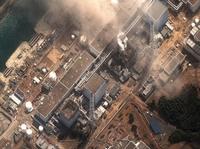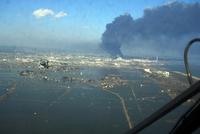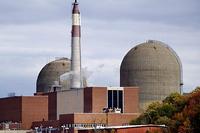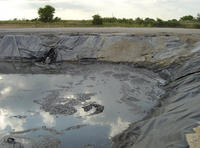-
Japan's nuclear crisis increasingly dire

Japan’s ongoing nuclear saga took a decided turn for the worse on Tuesday when a third explosion at a nuclear reactor may have cracked the containment unit protecting it, causing large amounts of radiation to leak out; the government requested assistance from the IAEA on Tuesday and teams were dispatched to help monitor radiation and human health; citizens within a thirteen mile radius of the Fukushima Daiichi power plant were evacuated and 140,000 residents within a twenty mile radius have been advised to stay indoors; officials also established a twenty mile no-fly zone around the power plant; officials in Tokyo reported that radiation levels were ten times their normal levels; experts say that these increased exposure levels do not pose an immediate threat to people, but the long-term effect remains unknown; the Tokyo Electric Power Company is considering using helicopters to pour cold water on top of overheating rooftops covering spent fuel rods; a small crew of fifty technicians at the badly damaged power plant is bravely fighting through high radiation levels and fires to contain the three reactors
-
-
EU considering subjecting nuclear plants to stress tests
The EU is considering subjecting the 150 nuclear reactors operating in Europe to stress test to check their safety in light of Japan’s nuclear crisis; the EU’s executive arm has no power to send experts to nuclear plants to see whether they are safe, but can discuss stress tests to see if EU nations would authorize them
-
-
Nuclear terrorism is a preventable catastrophe
Graham Allison, a nuclear proliferation expert, warns of the seriousness of the threat of nuclear terrorism and the ease with which rogue states or terrorists groups can obtain weapons or fissile material and the knowledge essential to developing production capability; “The number of rogue states and terrorist groups seeking to acquire nuclear weapons is increasing. There are a number of states willing to sell it to anyone, and a larger number of sites where enriched weapons grade plutonium and uranium can be found in conditions where they might be vulnerable to theft due to lack of security,” he says
-
-
Californians anxious about safety of nuclear reactors

The parallels between Japan and California are sobering: As in Japan, California’s two plants — Diablo Canyon near San Luis Obispo and San Onofre in Southern California — sit in active earthquake zones; like Japan’s, both rest beside the ocean and were built more than a quarter-century ago; perhaps most troubling, the San Onofre plant straddles two counties in Southern California with a combined population of 6 million people
-
-
OSI Systems to develop advanced cargo screening system
Rapiscan Systems, the security division of OSI Systems, Inc., was recently awarded a $29 million contract with DHS’ Science and Technology Directorate to develop sophisticated new cargo screening systems; the program is designed to produce the next generation of non-intrusive cargo screening systems that will be capable of automatically detecting and identifying multiple threats and contraband including explosives, narcotics, and chemical weapons in cargo containers entering the United States by air, land, and sea.
-
-
Official: U.S. safe from Japanese radiation

U.S nuclear officials said that there was very little chance that harmful levels of radiation from Japan’s nuclear reactors would reach Hawaii or the west coast of the United States; the head of the Nuclear Regulatory Commission (NRC) also said nuclear plants in the United States were designed to withstand natural disasters like earthquakes and tsunamis; readings from radiation sensors placed on the west coast have not detected any increases in radiation levels and experts do not expect any increases; Japanese utilities have flooded two nuclear reactors with sea water in a desperate attempt to cool them down and prevent a meltdown; the NRC has dispatched two nuclear experts to Japan to assist with efforts to keep three damaged reactors from melting down
-
-
Future of U.S. nuclear plans uncertain after Japanese nuclear crisis

As Japan continues its struggle to control its nuclear reactors, the future of the U.S. nuclear industry has become increasingly uncertain; nuclear power had emerged as the bipartisan solution to easing America’s dependency on oil; in February 2010, President Obama announced $8.3 billion in loan guarantees to energy companies to build the first new nuclear power plants in the United States in almost thirty years; some lawmakers have called for a moratorium and stricter safety regulations, while others are urging for a more measured response; Energy Secretary Stephen Chu and Gregory B. Jaczko, the chairman of the Nuclear Regulatory Commission, will testify before the House Energy and Commerce committee on Wednesday
-
-
Sector Report for Monday, 14 March 2011: Detection
This report contains the following stories.
Plus 1 additional story.
-
-
New technology allows detection of nuclear materials from a mile away
New detection technology would allow illicit nuclear material to be detected from up to a mile away; the technology, developed by the Idaho National Laboratory, will help protect the United States against the smuggling of nuclear materials into the country; field tests will begin this summer
-
-
Detecting invisible threats to first responders, soldiers
There are many methods currently being used that can detect chemical and biological agents and explosive compounds, but none allows for the unique fingerprinting of threat agents at trace levels; researchers have overcome this limitation with surface enhanced Raman scattering (SERS) using optically stimulated plasmon oscillations in nanostructured substrates; SERS offers several potential advantages over other spectroscopic techniques because of its measurement speed, high sensitivity, portability, and simple maneuverability
-
-
Army to request proposals for biological agent detection system
The Army is set to begin requesting proposals for the initial phase of its Joint Biological Standoff Detection System Increment 2 (JBSDS 2) program at the end of March; the program’s objective is to procure fully functional biological detection systems; JBSDS 2 is designed to provide devices capable of detecting, tracking, and identifying biological warfare clouds; the program specifies that the devices should be capable of identifying any biological agent, organism, or poison that is capable of killing, incapacitating, or impeding a large force
-
-
Army signs deal with ChemImage for explosive detection technology
The U.S. Army’s Space and Missile Defense command recently signed a $17 million contract with ChemImage Corporation to implement its real-time sensor technology to detect explosive threats in the field; ChemImage’s technology would give U.S. troops the ability to identify objects from a distance to determine if they are explosive, chemical, or biological threats; the devices rely on molecular spectroscopy and digital imaging to analyze material
-
-
Explosive-detecting rats to save soldiers' lives

An Oklahoma State University researcher received a $740,000 grant from the Department of Defense to conduct the research into using rats as landmine sniffers; rats have three advantages as bomb sniffers: the rodents, about the size of a small cat, can cover a lot of ground quickly; their acute sense of smell enables them to sniff out land mines, but they are small enough that they do not detonate the mines; also, they do not form attachments to their handlers so anyone could deploy them
-
-
Radioactive waste contaminates drinking water, EPA does nothing

Recent Environmental Protection Agency (EPA) documents show that Pennsylvania’s drinking water has been contaminated with radioactive waste from natural gas drilling; energy companies have been extracting natural gas with a new drilling technique called “hydrofracking”; this process results in millions of gallons of wastewater that is contaminated with dangerous chemicals like highly corrosive salts, carcinogens, and radioactive elements; EPA documents reveal the process has been contaminating drinking water supplies across the country with radioactive waste; in Pennsylvania more than 1.3 billion gallons of radioactive wastewater was trucked to plants that could not process out the toxins before it released the water into drinking supplies
-
-
DHS interested in systems for covert body scans
DHS has signed contracts for the development of mobile and static systems that can be used scan pedestrians and people at rail and bus stations and special event venues — apparently at times without their knowledge; DHS moved to develop the technology as part of an effort to bolster the ability of law enforcement personnel to quickly detect concealed bombs and other explosives on individuals
-
- All
- Regional
- Water
- Biometrics
- Borders/Immig
- Business
- Cybersecurity
- Detection
- Disasters
- Government
- Infrastructure
- International
- Public health
- Public Safety
- Communication interoperabillity
- Emergency services
- Emergency medical services
- Fire
- First response
- IEDs
- Law Enforcement
- Law Enforcement Technology
- Military technology
- Nonlethal weapons
- Nuclear weapons
- Personal protection equipment
- Police
- Notification /alert systems
- Situational awareness
- Weapons systems
- Sci-Tech
- Sector Reports
- Surveillance
- Transportation
Advertising & Marketing: advertise@newswirepubs.com
Editorial: editor@newswirepubs.com
General: info@newswirepubs.com
2010-2011 © News Wire Publications, LLC News Wire Publications, LLC
220 Old Country Road | Suite 200 | Mineola | New York | 11501
Permissions and Policies
Editorial: editor@newswirepubs.com
General: info@newswirepubs.com
2010-2011 © News Wire Publications, LLC News Wire Publications, LLC
220 Old Country Road | Suite 200 | Mineola | New York | 11501
Permissions and Policies
